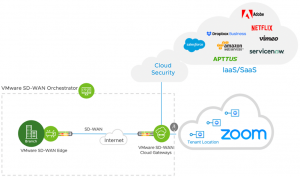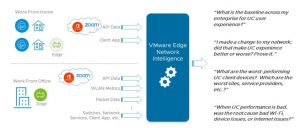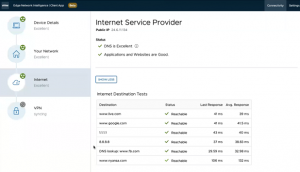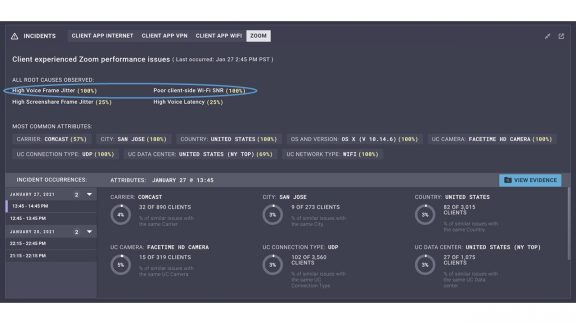Historic changes have brought unified communications (UC) to the forefront of the way we work, live, and learn. For enterprises, it enables employees to be productive and collaborate with one another. In environments like universities, it enables students to continue to gain a strong education from home, when they can’t attend classes in person. And for healthcare, unified communications helps doctors stay connected with their patients, to help ensure better outcomes.
Given the importance of unified communications, it’s more important than ever to assure the best possible performance and availability of leading applications like Zoom.
Performance requires visibility and control
What’s required to ensure a great Zoom experience? It starts with visibility and control. Traditionally, with onsite users, enterprises gain visibility into Zoom performance and application usage through routers, wireless controllers, and other devices. These enable IT organizations to examine and classify Zoom traffic and take steps to ensure performance is optimal.
However, many of today’s enterprise users are connecting from home, using consumer-grade equipment such as cable modems and inexpensive routers. They may share Internet bandwidth with others in the home, and IT has only limited visibility into usage. With these home users, it’s difficult to gain detailed insight into how people are using Zoom and whether they are getting good performance. If something goes wrong, poor performance could be caused by anything from consumer-grade Wi-Fi issues, Internet connectivity problems, or issues with the application itself.
For these types of use cases, IT is almost blind from a reactive standpoint, let alone a proactive standpoint of being able to identify the cause of problems. Although users who have issues may not complain, that doesn’t mean their productivity is maximized. Ideally, enterprise IT should know if a user is experiencing poor performance, and should have the ability to reach out, advise them of the issue, and suggest a remedy.
Integration for proactive insight
VMware SD-WAN™ and VMware Edge Network Intelligence™ enhance the Zoom experience for users, regardless of their location and devices. If a user is connecting from home, VMware Edge Network Intelligence can provide insight from the device, tracking the status of its wireless state, Internet stability, gateway connectivity, and other factors that can impact performance. From the desktop to the cloud, VMware Edge Network Intelligence provides an end-to-end evaluation of underlying network conditions that can affect a user’s collaboration experience.
The Zoom application itself can also provide valuable details about every end client device’s Zoom user experience. With these two data sources feeding into the VMware Edge Network Intelligence platform, together with big data analytics, enterprise IT gets the visibility and full context they need to determine user experience baselines across the entire enterprise, depending on location, device, the client OS used, and more—all automatically learned.
Enterprise IT teams regularly modify their networks, even for remote users. They may provide VMware SD-WAN Edge devices to people working from home or adding Internet bandwidth to sites. How can they prove that these modifications have actually improved performance and availability for users? With VMware Edge Network Intelligence, once the baseline is learned, it’s easy for administrators to view the state of the network both before and after changes.
Moving from reactive to proactive management
Enhancing visibility is great for accelerating troubleshooting and improving uptime. But ultimately, enterprise IT teams are seeking to become more proactive, stopping issues before they can impact business processes.
To move to a more proactive stance, IT needs to consider some key questions. How do we proactively surface the worst-performing client devices that are having problems over and over again? What are the worst-performing service providers? What are the worst-performing sites? What are the worst types of operating systems of users that are using Zoom? Gaining proactive insight into these and other issues allows enterprise IT to proactively reach out to users—fix problems before people start complaining about them.
Finally, organizations need to correlate issues and identify root causes, to be sure that the problems users are encountering are the actual issues that IT is addressing. For example, if Wi-Fi is the root cause of a user’s bad Zoom experience, then adding more Internet bandwidth to that user will not fix the issue. Similarly, if Internet bandwidth is the problem, then buying the user a better laptop or other device will not improve the experience.
Knowing the root cause of the problem for the various client devices accessing Zoom is critical. To do it, it’s essential to acquire data from multiple sources. The Zoom application provides visibility into the end client application experience. Other data sources give us insight into the wireless state of the device, device health, internet stability, gateway stability, and more.
The beauty of VMware Edge Network Intelligence is its ability to take all of these data sources, describe every single end client device in the environment, automatically consider the most relevant questions about the issue, and determine the root cause of the problem—before making recommendations about how to mitigate it.
Privacy and security
Privacy and security are top of mind for users and organizations, so gaining insight into users’ endpoint devices should be minimally intrusive. VMware Edge Network Intelligence collects only basic statistics about the device, such as CPU usage, battery levels, the type of Wi-Fi adapter, and other basic information.

The solution also collects data related to wireless signal strength, signal to noise ratio, the user’s wireless speed, signal level, and connectivity to their local gateway. It performs tests against a pre-configured list of target destinations over the Internet, as well as over the user’s VPN, to ensure that Internet stability, gateway stability and VPN stability are maintained. Throughout the process, VMware Edge Network Intelligence cannot see what users are actually doing.
The client application itself is simple and intuitive, gathering data about the device and its connectivity, and sending the information back to the VMware Edge Network Intelligence platform.
To determine the root cause of an issue, the solution takes a deeper look at all these variables. For example, as shown in the screenshot below, if a user experienced poor Zoom performance, the cause would appear to be high voice frame jitter from the Zoom application’s perspective.
In this example, VMware Edge Network Intelligence can correlate the high voice frame jitter with poor client-side Wi-Fi signal-to-noise ratio (SNR). It’s a wireless root cause of what ends up being an application performance problem.

VMware Edge Network Intelligence acquires wireless data from the client device, as well as Zoom API data, and automatically correlate and analyze them. Note that the Zoom API provides immense information to VMware Edge Network Intelligence about Zoom user experience including jitter, loss, latency, bit rate and resolution specific to screensharing, audio and video. Based on the analytics, VMware Edge Network Intelligence has determined that the user experienced Zoom issues, and that the root cause of the issue was the wireless environment—not the Internet, application, or other elements. This type of data can also be utilized if a user would like to self-troubleshoot, before contacting a help desk.
Two complementary solutions
VMware Edge Network Intelligence is integrated into VMware SD-WAN. They work together, combining data to reveal who is having problems, why they are having problems, and how to fix them.
However, an SD-WAN architecture is not required to gain better visibility into Zoom performance. The VMware Edge Network Intelligence platform calls APIs from the Zoom cloud in order to build insight into employees’ Zoom experience, even without an SD-WAN environment.
When VMware Edge Network Intelligence is augmented with VMware SD-WAN and VMware Edges, organizations gain more information on how to fix the issues. Additionally, VMware SD-WAN can take control actions to actively prioritize and optimize Zoom application performance in response to issues. Because it’s not always practical to distribute physical VMware SD-WAN Edges to every user that requires them, organizations may want to start by first determining which users experience the most frequent issues, and prioritizing delivery of Edges to those sites. With the right approach, VMware Edge Network Intelligence and VMware SD-WAN can enable organizations to realize the full value of their unified communications investment, and better support an increasingly remote workforce.
Ready to learn more?
If you’d like to learn more about how VMware SD-WAN and VMware Edge Network Intelligence can help you ensure the best possible user experience, regardless of location, check out our solution overview.
More resources
- Learn how SD-WAN makes working from home faster and more secure, and get new pricing options, on our work-from-anywhere page
- Download the eBook VMware Edge Network Intelligence: Raising the Bar for AIOps in the Distributed Enterprise






